There are vital points when hot smoking fish, with a few techniques and temperatures you can use. Hopefully, I can share some of my successes over the years.
KEY Steps
How to Hot Smoke Fish:
- Acquire fillet or Whole Fish
- Cure or Brine Fish
- Form the Pellicle
- Smoke Fish in Hot Smoker
Key Points
- Acquire sustainable fish options, considering local sources and the benefits of oily versus white-fleshed fish.
- Cure or brine fish using dry or wet methods, adjusting salt and sugar ratios based on fish size and desired flavor.
- Forming a pellicle by air-drying fish on a non-reactive rack or shallow dish allows airflow for optimal smoking.
- Smoke fish in a hot smoker, maintaining temperatures between 160-190°F (70-90°C) for ideal results.
- Serve hot smoked fish with creamy accompaniments in pasta dishes, dips, patties, pate, quiche, or kedgeree for a delightful culinary experience.
We will also talk about the different equipment for hot smoking you can use.
To say I love smoked fish is a super understatement. More often than not, I catch and hot smoke.
I also buy hot-smoke salmon and plenty of other fish species. I searched far and wide and couldn’t find a decent guide for all the various fish hot-smoke, so I thought about sharing.
Over a few decades of hot smoking experiments, reading many books, and eating heaps of fish. Here is the overview of how I hot smoke fish.

How to Hot Smoke Fish
Smokey flavors work so well with many varieties of fish. And, of course, once you get the hang of it, it’s way better than anything bought in a shop.
Equipment shouldn’t be a hassle; tin foil and a wok/pot can work. I’ll go over all the different slow and fast smoking options.
I want to help you try, so I will highlight different techniques you can use.
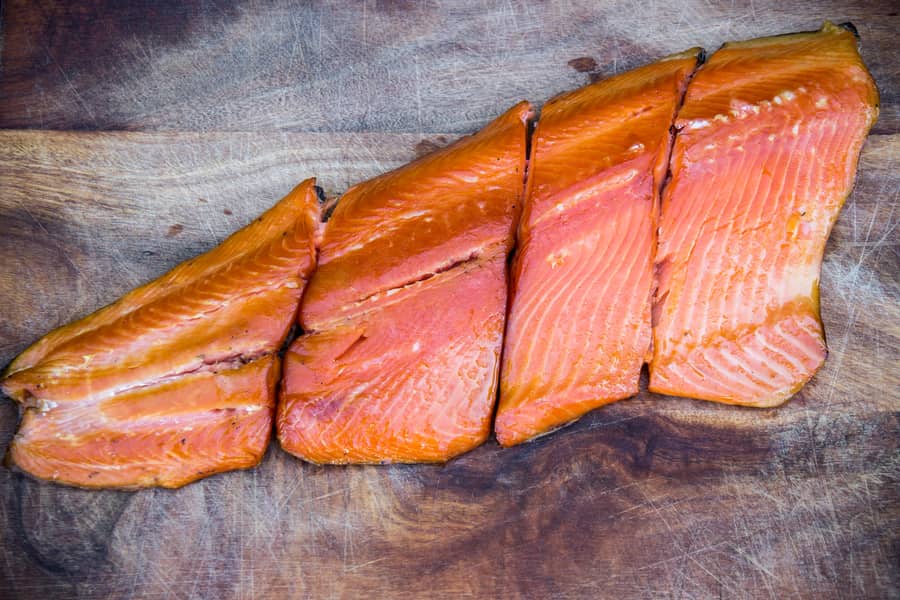
I am using a small setup or a large one.
When I did start investing in smokers, for me, it was about getting consistent results and being low maintenance. I’ll go over all these techniques for you.
1. Acquire Fillet or Whole Fish
Fish or other seafood crustaceans.
Knowing your fish is sustainable is necessary, of course. Our choices decide the future of fish populations. Local, of course, helps our planet, too.
Oily Fish
- Salmon
- Tuna
- Sardines
- Sea bass
- Mackerel
White Flesh Fish
- Orange roughy
- Gurnard
- Flounder
- Snapper
- Halibut
- Pollack
- Trout
When choosing fish (or catching it), oily fish retain more moisture and considerably take up smoke flavor. They don’t overcook as easily as white delicate fish.
Both will turn out awesome; do it!
If you get this fish with the skin on, it will hold the flesh together better when smoking and cooking. Oily fish are healthier in terms of the richness of OMEGA 3 & 6.
Oily fish also take on wood smoke very well.
2. Cure or Brine Fish
Basic Dry Curing Recipe
- 2:1 ratio salt / natural raw sugar – so for every 5 grams of salt, I will use 2.5 grams of sugar
- (add herbs/spices if you want)
You want enough cure to dust over all sides. It depends on the size of the fish portion/fillet or whole fish. I find 1-2% salt for the total weight of the fish to be just suitable for hot smoking (it’s about flavor/light curing, not complete curing).
For example, fish fillet 9 oz/ 250g – 1.5% salt = 3 grams (just over half a teaspoon). 1.5 grams of raw sugar.
I use accurate scales a lot, especially for dry curing meat, I highly recommend this since salt granules have different shapes/sizes, One teaspoon of Morton salt is entirely different from one teaspoon of kosher salt – or various other types/sizes/brands.
For an idea of recommended accurate scales (life-changers for many cooks around here – exceptionally accurate meat curing), here is a page of a few decent ones I put together.
Using finer salt (sea salt) will mean faster penetration. Most people seem to prefer coarser salt, though. Coarser salt, like kosher salt, is a good choice if you are overnight curing. Below are some examples of how much I sprinkle.
Some people like to wrap the fish in cling film, plastic wrap, or glad wrap. I prefer not to use single-use plastic, so I use a shallow dish or plate. Depending on the moisture content, this may draw out moisture in the fish, so you want something to catch the liquid.
I prefer not to use more
Basic Wet Brine Recipe
Easy Ratio 5% Salt Weight to Water Weight
50 grams/1.8 oz sea salt/kosher salt to 4 cups of water (1 Litre)
or
15 grams/1 tablespoon of salt per cup of water – approx
You only need to submerge the fish, so you don’t need gallons or liters unless you do a big batch of fish.
You might need to place a clean weight on top, like a plate or something, to hold the fish under the salt brine water.
Length of Time in the Brine
As a rough
Here is some more helpful information as a guide:
| Fish | Thickness/Size | Curing Time |
|---|---|---|
| Trout Fillet | 1/2 inch (13mm) | 30 minutes to 4 hours |
| Salmon Fillet | 2 inches thick | 4 hours minimum, Overnight |
| Kippers/Sardines | Smaller fish fillet | 10 minutes to 1 hour |
Rinse with water thoroughly and then on to form a pellicle.
As you can see above, leaving it in brine longer is not a big issue. However, overnight is generally long enough for thick fish (definitely not more than two days).
Fish is less dense
Optional: (Add fresh herbs, bay leaf, peppercorns, white wine, or dried herbs to suit).
Note—It’s harder to form a pellicle from a frozen fish, so it’s harder for the smoke flavor to impart its vapor (it is not the smoke; it’s the vapor from the smoking that has the taste).
The weight/volume of salt can vary, but this will give you a good guide based on the 5% ratio. You may want to experiment with stronger brines if you often consume more amounts of smoked fish.
You may want to consider a salt tester, which floats to show how accurate your salinity level is. You should only look at these if you are doing huge batches of fish.
You can soak the meat in fresh water after
3. Form the Pellicle
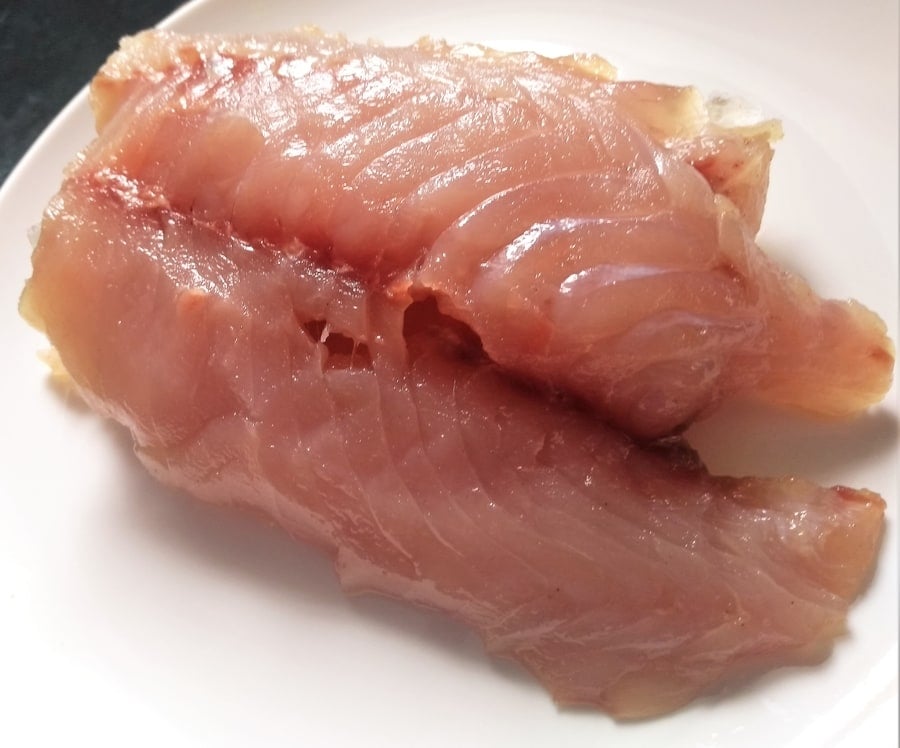
Put fish on a non-reactive rack or /wooden skewers for airflow. Stick it in the fridge or a ventilated area. Another option is inside your cool-protected smoker if it has some airflow and it’s moderately cool outside, say under 50°F/10°C.
If it’s a whole fish hanging, it can work well. Some basic techniques are needed so the head doesn’t fall off when hung.
To get a dry, tacky protein formation on the meat, it just needs a little time in a cool area & airflow around it.
Some people use wooden skewers on a shallow dish to create air circulation around the meat.
4. Smoke Fish in Hot Smoker
Temperature & How Long to Hot Smoke for
The lower the temperature, the better, while cooking the fish for every method. If you can get smoke and run direct-heat smokers at 160-190°F/ 70-90°C, this would be ideal. It’s done once the fish flakes and is cooked through; a picture of flaking is below.
How Long to Hot Smoke Fish?
The key to success is ensuring the fish is cooked; you test how easily it flakes off the fillet (pull a fork through it and see if it’s flaking or raw).
A digital thermometer is helpful; it’s cooked at 150°F/63°C (commercial smokers would want the internal temp to remain at this level for 30 mins personally if it’s cooked – it’s done for me)
Hot Smoking Tip: When the salmon is done, it may ooze some white stuff. This is albumin, just protein—nothing to be concerned about (you are highly likely to see this with Salmon). When the protein is very cold from the fridge, the heat contrast extrudes it.
Doesn’t change flavor.
In short, there are two main methods to hot smoke
Fast higher temperature or slower low temperature.
Fast Direct Hot Smoking (Wok or Portable Smoker)
If the fillets are thin or a small fish, it can take 6-8 minutes.
For thicker fillets of salmon, hake, or monkfish – this could take 15 minutes.
Making sure the temperature is low after the smoking starts is essential.
Indirect Smoking (or Low & Slow)
It depends on thickness.
| Light Smoking | 200°-240F / 95-115°C | Under 1 Hour |
| Medium Smoking | 170-190°F / 70 – 90°C | 1-2 Hours |
| Intense Smoking | 150-160°F / 65 – 70°C | 2-5 Hours |
A thermostat-controlled smoker (electric or gas) will be the way to get the most success here if you want that convenience factor (set & forget). More on this below.
If you want a decent gadget to make the whole smoking fish project easier, here is a page that reviews the pros and cons of a few digital thermometers I can recommend.
Hot Smoking Fish Smokers
Direct Heat a fast higher temperature method:
- Wok/Pot smoking -indoor smoking option
- Portable Smoker – needs an
outdoor heat source
Indirect Heat slower low-temperature methods like ‘Low & Slow’:
- Electric/Propane/Gas Smoker
- Pellet Grill Smoker
- Kettle, Drum, or Offset Smoker
- Pellet Tube Smoker/Maze Smoker
For the direct heat methods above, I would put the fish in the smoker while it heats up to capture more smoke flavor.
For indirect heat below, I would wait until the smoke/heat has reached approximately 200°F/100°C – then add the fish for smoking.
Now, I will go over the different hot smokers for fish.
Direct Heat Hot Smoking
Tea Smoked Wok/Pot Stove Top
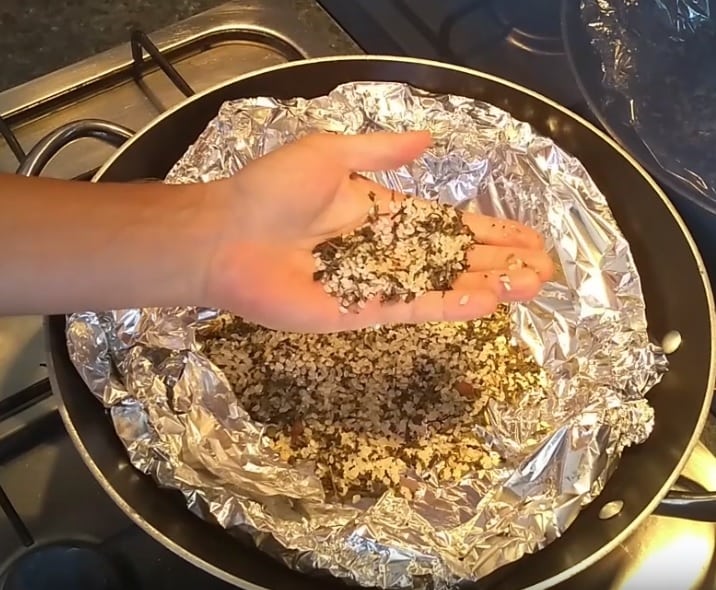
You can have some real fine with this traditional Chinese style. The tea smoke has an entirely different flavor from wood smoke, and the addition of sugar also gives it a caramel and aromatic spice flavor.
- Essential Equipment – pot, lid, aluminum foil & tea/wood
- This can make the kitchen very smokey! Depends on the mixture
- Recipes & techniques on Tea Wok Smoking over here
Portable Smoker
I want to open the portable smoker like the one below to allow more airflow. Too much smoke can cause the fish to have a bitter taste.
Half a handful of smoking wood (pellets, chips, sawdust) is enough.
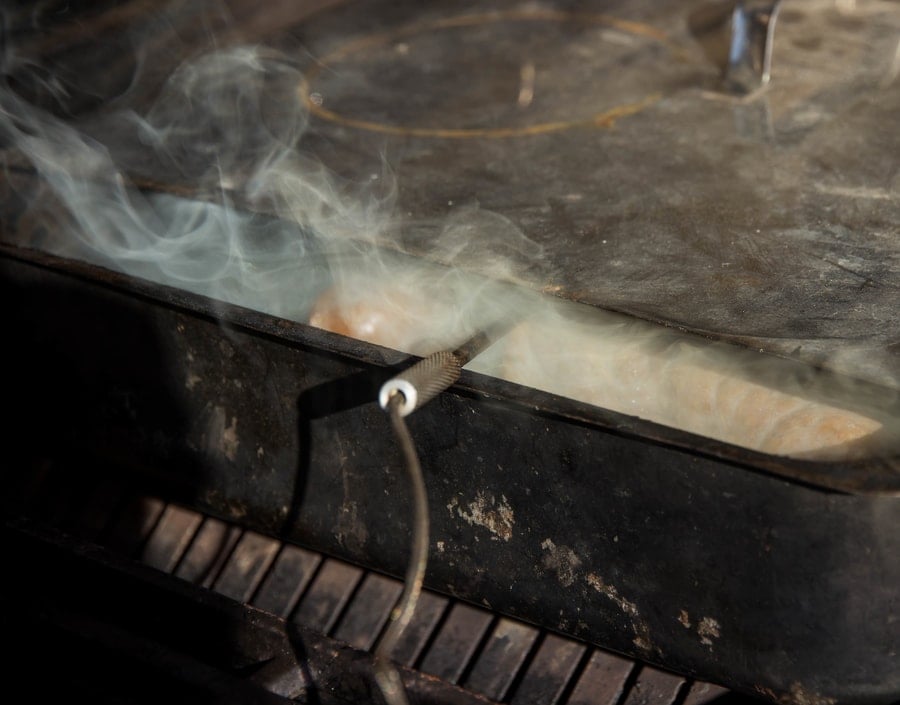
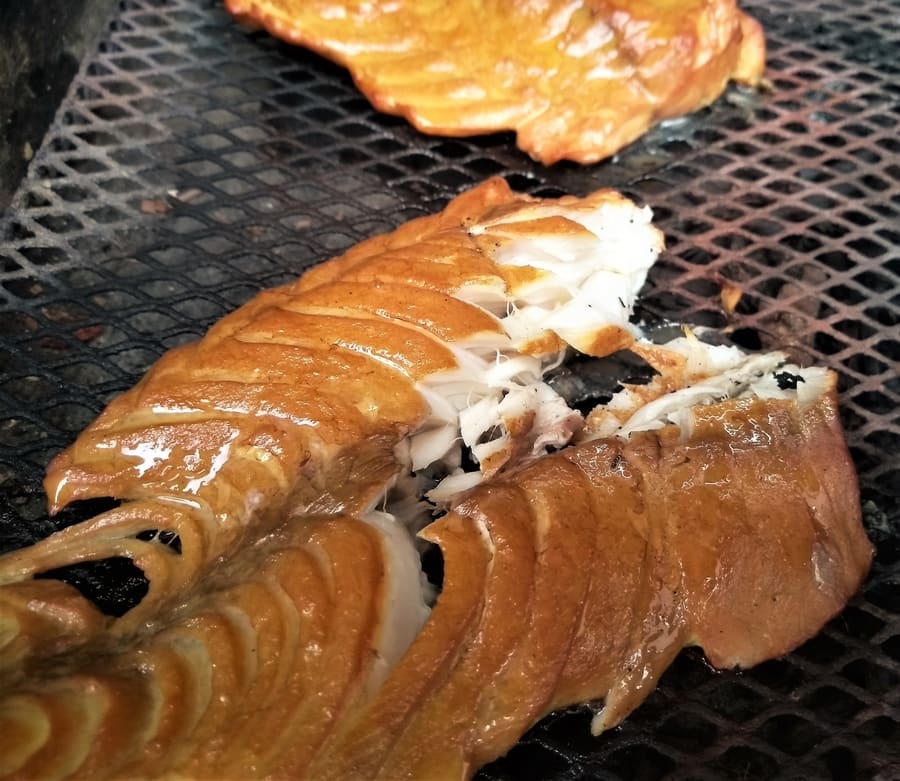
It is an excellent device for fast, hot smoking; I use a portable smoker a lot! It’s simple to set up for a quick smoking session.
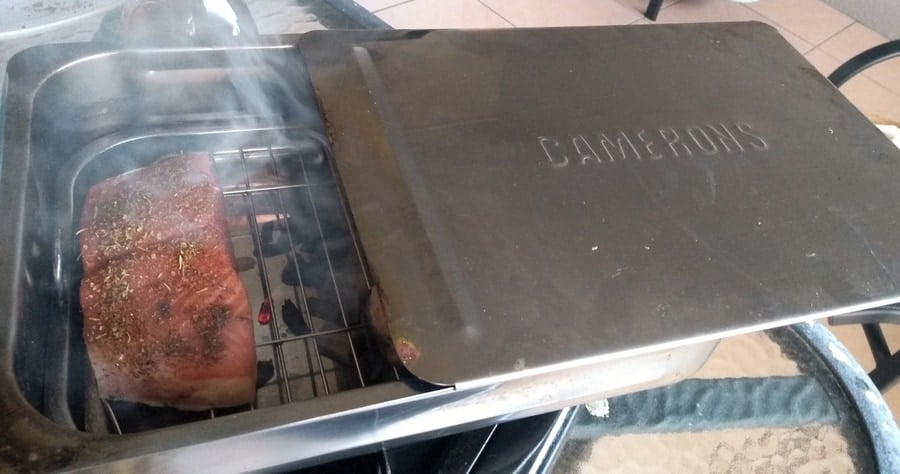
For many friends who want to try smoking, this is what I suggest: not much of an investment either.
It is used on an outdoor heating device, such as a spirit burner, gas cooker, gas grill, or heating element.
This is an easy and fast way to add smoke flavor to your fish. It can be limiting if you want to hot smoke a big fish, but I have sometimes just cut up the fillets to fit inside the smoker.
This method tends to be quite direct heat, so keeping an eye on it is crucial. But it’s OK for under 20 minutes of smoking—e.g., trout, salmon, or 1/2-inch fillets.
- Use it for camping, fishing, or fast, hot-smoking sessions.
- Portable smoker favorites of mine: sausage (straight in, chorizos), fish fillets, whole fish & pork chops
- Not for indoor use, too much smoke – porch or backyard is perfect
The design needs to be well sealed to get some good, intense smoke; for more info on these portable smokers, I wrote more details here.
Indirect Heat Hot Smoking
For all these indirect-heat hot smokers, maintain 170-190°F/70-90°C, then use a fork to test when the fish starts to flake.
Electric/Propane/Gas Smoker
This type of smoker, which has a consistent temperature once set, is straightforward. The same is true for pellet grill smokers (pellet grill smokers are more of an investment).
You can’t go wrong with one of these if you want the dedicated smoker since it is a genuine set & forget option.
However, electric smokers are the best option for cost, convenience, and ease of use. You use a temperature-controlled thermostat to smoke fish, and the cured fish goes in with a pellicle formed. Here’s a write-up with some electric smoker suggestions.
It’s the same idea as the electric one but with propane/gas as the fuel type.
Remember, hot smoking is cooking/baking the fish, with some smoke happening at the same time. So it’s all about having a go, and if you love smoked goods -maybe investing in some gear is necessary.
Pellet Grill Smoker
Indirect heat, low temperature – basically like an outdoor oven heated with wood pellets that flavor the food.
Electricity is needed for the auger that pushes and controls the pellets that are burning/smoking.
Kettle, Drum, or Offset Smokers
Airflow management is the key to any of these types of charcoal for wood smokers. They all have air in and air out. This airflow controls the burning and, therefore, the heat. It can take some tweaking.
Many smokers are out there, but I want to focus on the easiest to use and one of my favorites, the kettle grill. I talk about how easy it is a bit in this post about… easy to use smokers!
I use the ‘snake method,’ which involves placing the heat on one side and the fish on the other.

Then, the fish can look like this after 2-3 hours.

Pellet Tube Smoker/Maze Smoker
It can be added to a gas grill, so you have a burner on one side for indirect heat and a pellet tube smoker under the hood for the smoke.
It’s a great gadget to add to a gas or kettle grill (here are some other excellent tools I wrote about in detail). It creates either hot or cold smoking.
- Pellet tube smoke can also boost charcoal smokers
- Woodchips or wood pellets can be used effectively.
For more info on pellet tubes, I wrote about my favorites here and why.
For Recommended Gear,
- Portable Smokers (for direct smokers for gas grill or any outdoor heat source – fish fillets, sausages, red meat, chicken, etc., whatever you can fit in it)
- Tube & Pellet Tube Smokers (add to a gas grill, charcoal, electric, or you can easily use them for some cold smoking action)
- Easy Electric Smoker (thermostat controlled smoker (an oven with smoke basically – smoke anything in one of these, versatile and reasonable price which can be used for so much…turkey, ribs or salmon – indirect smoked low and slow)

Quick Smoker for Gas Grill Tip Wood Chips Foil Wrapped
Wrap a handful or two of wood with tinfoil/aluminum foil and poke some holes like this.

You then want to place it directly above a burner. I’m not too fond of this method when you use a hooded gas grill since burning tin foil, or aluminum foil isn’t perfect for flavor.
Other Helpful Information – Hot Smoking Fish
Choose Smoking Wood
Sawdust, wood chips, wood chunks — there are so many options. Note that sawdust will burn fast; I tend to soak it for 20 minutes. Soaking doesn’t make the wood smoke longer; it just delays combustion. The real benefit is adding moisture to the heat/smoke environment.
Recommended Smoking Woods
| Type of Wood | Suitability for Smoking | Additional Notes |
|---|---|---|
| Hardwoods (Deciduous Trees) – Ideal for Smoking Meat | Yes | Opt for fruit or nut wood for smoking fish. These deciduous hardwoods don’t have resin and provide a pleasant flavor to the meat. Common choices include apple, cherry, pecan, and hickory. |
| Non-Treated Wood | Highly Recommended | When making your own smoking wood, ensure it is non-treated to avoid any chemicals embedded in the wood. If purchasing, choose from reputable stores that stock untreated smoking wood. |
Woods to Avoid for Smoking:
| Type of Wood | Reason for Avoidance |
|---|---|
| Softwoods (Evergreens/Coniferous Trees) | Best to avoid smoking. |
| Cedar | High resin and oil content. |
| Cypress | High resin and oil content. |
| Elm | Not recommended for smoking. |
| Eucalyptus | Not recommended for smoking. |
| Pine | High resin and oil content. |
| Fir | High resin and oil content. |
| Spruce | High resin and oil content. |
| Sycamore | Not recommended for smoking. |
| Any wood with high resin and oil | Best to avoid for smoking. |
There are lots of opinions about what is best about wood. I like to keep it simple, so I wrote an easy guide if you want to check out the post – here it is.
Wood Plank/Board for Hot Smoked Fish
Smoke on a wooden plank! Buy it, find it, or make it – it’s a novelty to smoke a fish on a plank. It’s a subtle smoke unless you’re adding another smoking box to the mix, but it does make an excellent presentation for friends and family.
Soaking the plank for 30-60 mins, and you’re good to go. If the plank is slightly larger than the fish, the smoke around the edges will flavor the fish (very subtle).
Big planks don’t flavor with smoke much due to the distance it creates from the burning and smoking to the fish. A giant board can make an eye-catching serving board, though.
You are using a wood, charcoal, or propane grill for this.
Plank cooking woods I have used (basically any smoking wood):
- cedar
- alder
- maple
- hickory
- pecan
- oak
- cherry
- apple
Intensifying the Smoke Flavor
I eat smoked fish immediately, on its own or in a recipe. Also, if you put it in the fridge for a day or overnight, it tends to taste smokier (in a container, or else the fridge will smell pretty smoky).
Serving Hot Smoked Fish
Works very well with something creamy, like cream cheese or avocado.
Many pasta options can be delicious.
Make a hot smoked fish dip! Superb sharing food.
Here are some other suggestions:
- Make a pate, something creamy like cream cheese and some zest
- With eggs or with eggs benedict
- Make some smoked fish patties
- In a quiche is a great idea
- If you haven’t tried kedgeree, give that a go (smoked fish eggs, curry, rice, and spice)
Related Questions
Can I Smoke Fish in an Oven?
This can be
Check it out here, tea smoked fish in a wok/pot
How Long Will Hot Smoked Fish Last?
One week in the fridge. Vacuum-packed, it will last up to three weeks. If it is not refrigerated, hot smoked fish is the same as cooked meat and will not last unless kept in a cool area. If it has been salt-cured or brined, it can last a few more days than non-hot smoked(my rtrout smoking article here) fish.

Tom Mueller
For decades, immersed in studying, working, learning, and teaching the craft of meat curing, sharing the passion and showcasing the world of charcuterie and smoked meat. Read More

Just purchased a second hand charcoal kettle smoker and I found your post very helpful. Just about to give it ago with a bit more confidence than I did before I read this, many thanks
Elise
awesome Elise! Glad to hear it!
I smoked some tuna, as a dry run for Father’s Day 2021 ( Please excuse the pun ) with your suggestions and step-by-step advice it turned out great . Planning to have the kids over next Sunday I know the smoked fish will be a big hit it will be a great addition to the table. Many thanks Cliff
Hey Cliff, thanks for the comment – sounds like you nailed it! Nice! Tom